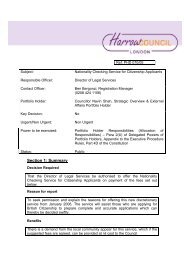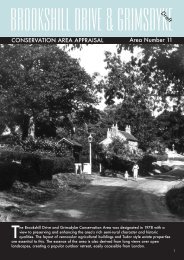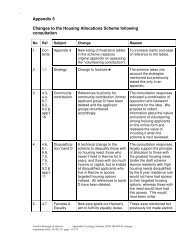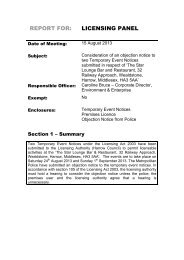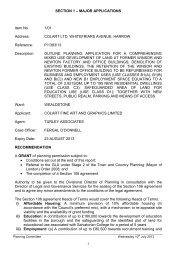London Fire Safety Guidance for Houses in ... - Harrow Council
London Fire Safety Guidance for Houses in ... - Harrow Council
London Fire Safety Guidance for Houses in ... - Harrow Council
Create successful ePaper yourself
Turn your PDF publications into a flip-book with our unique Google optimized e-Paper software.
DoorsTECHNICAL POINTS APPLICABLE TO ALL CATEGORIES OF FIREDOORSThickness of door leafThe thickness of the door leaf is no longer a reliable guide to fire resistance assome th<strong>in</strong> proprietary door leaves are now commercially available. However,traditionally 30 m<strong>in</strong>ute doors are 44mm thick; 60 m<strong>in</strong>ute doors are 54mmthick.Self-clos<strong>in</strong>g devicesIn the event of fire it is essential that a fire resist<strong>in</strong>g door is closed andsecured with<strong>in</strong> its frame to provide an effective fire barrier. Self clos<strong>in</strong>gdevices are there<strong>for</strong>e essential (except to doors to locked cupboards). Wherelatches are not fitted, the device must reta<strong>in</strong> the door leaf <strong>in</strong> the closedposition until the <strong>in</strong>tumescent seal has been activated. Dur<strong>in</strong>g a fire situation alatched door will be secured <strong>in</strong> its frame by the mortise lock or latch but <strong>for</strong>corridor doors where locks and latches are <strong>in</strong>appropriate it is the self clos<strong>in</strong>gdevice which must per<strong>for</strong>m this function. BS 5588: Part 1 Clause 18.b.2(c)makes the follow<strong>in</strong>g recommendations <strong>for</strong> door clos<strong>in</strong>g devices :~ They should not be capable of be<strong>in</strong>g disconnectedeasily.~ They should override any latches or seals fitted to thedoors~ They should be of a type that has been shown by firetest, <strong>in</strong> accordance with BS 476: Part 22 : 1987 (or Part8 subsequent to 1981), to be capable of hold<strong>in</strong>g the door<strong>in</strong>to the frame until the <strong>in</strong>tumescent strip has beenactivated.They should effectively close the door from any angleElectro-Magnetic Door HoldersNo means should be provided <strong>for</strong> hold<strong>in</strong>g a self-clos<strong>in</strong>g fire door <strong>in</strong> an openposition other than an Electro-magnetic door holder or approved alternativealarm sensitive door holder.Electro-magnetic door holders are only permitted where the doors do notenclose a s<strong>in</strong>gle escape stairway and provided they are l<strong>in</strong>ked to the firealarm/detection system. (Build<strong>in</strong>g Regulations 1991, Approved Document B,Appendix B). Mechanisms that are required to be released manually are notpermitted <strong>in</strong> any circumstancesElectro-magnetic door holders have the advantage of elim<strong>in</strong>at<strong>in</strong>g the practiceof wedg<strong>in</strong>g or propp<strong>in</strong>g fire doors open where they frequent day to day use.<strong>London</strong> <strong>Fire</strong> <strong>Safety</strong> <strong>Guidance</strong> <strong>for</strong> <strong>Houses</strong> <strong>in</strong> Multiple OccupationVersion 2: 06/06







